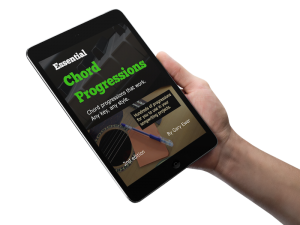Do you find yourself wishing that your chord progressions were just a little more interesting? Here’s a quick tip for taking something that’s basic and simple to come up with something that sounds more imaginative: transpose your progression.
Here’s what I mean. Let’s say that you’ve been improvising on a simple progression like: C Dm G Am. It’s a good progression, of course, but you may find that your melodic ideas are all sounding a bit boring, possibly because the progression underneath is sounding a bit too simplistic.
 Stuck with how to get chords that fit the melody that’s rolling about in your musical mind? “How to Harmonize a Melody” will show you how to do it, with sound files that demonstrate the process. Get it separately, or as part of “The Essential Secrets of Songwriting 10-eBook Bundle.”
Stuck with how to get chords that fit the melody that’s rolling about in your musical mind? “How to Harmonize a Melody” will show you how to do it, with sound files that demonstrate the process. Get it separately, or as part of “The Essential Secrets of Songwriting 10-eBook Bundle.”
You can extend that progression by repeating it with a transposition of itself, and there are several ways to do this, but here’s a simple way: play the initial progression, and then transpose it to start a 4th higher. If you transpose that progression a 4th higher, you get: F Gm C Dm. Now play both progressions together and you get this:
C Dm G Am|F Gm C Dm
The transposed part of the progression ends on a Dm, which will slide nicely down to C, and you can play the eight chords again if you want.
The transposition of the original four chords means that you’ve really pulled your song temporarily into a new key. But you’ll also notice that three of the four chords of the transposed progression (the F, C and Dm) also exist in the original key of C major. So the transposition isn’t as odd as you think it might be.
There are other transpositions you can try as well: Try a move into D major: C Dm G Am |D Em A Bm (The most unique part of this transposition is moving from Bm at the end back to the C).
A modification of this idea might be to take a simple progression and then insert a short transposition of two of the chords in the middle. It would work like this:
- Take a simple progression: C Dm F G
- Transpose the final two chords, let’s say, up a major second, which would give you: C Dm F G |G A
- Then repeat the final two chords of the initial progression: C Dm F G |G A F G
Each time you jump from one key to another in this way, you’re using what’s termed an abrupt modulation, where the key change happens with no musical preparation: it simply jumps from the original key to the new one, and back again.
For that reason, you’ll want to be sure you’re using a transposition that works well with the original key, to avoid a situation where the change is distractingly obvious.
The benefit of using transposition in this way is that you extend an initial progression by borrowing chord relationships from that progression to create a new one. In other words, the new bit that you’re adding uses the original relationships between the chords to create new ones. In that sense, it’s like adding a kind of musical glue that pulls everything together.
 Written by Gary Ewer. Follow Gary on Twitter.
Written by Gary Ewer. Follow Gary on Twitter.
 Sometimes all you need are lists of chords to get the songwriting process started. The Essential Secrets of Songwriting 10-eBook Bundle includes “Essential Chord Progressions” and “More Essential Chord Progressions.” Use the suggested chords as is, or modify them to suit your own songwriting project.
Sometimes all you need are lists of chords to get the songwriting process started. The Essential Secrets of Songwriting 10-eBook Bundle includes “Essential Chord Progressions” and “More Essential Chord Progressions.” Use the suggested chords as is, or modify them to suit your own songwriting project.










